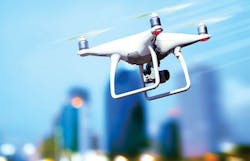Inspecting your building envelope and roof is no easy feat. The taller your building, the more dangerous it is to gain access to the upper levels. Plus, the time-consuming nature of the work makes it expensive, especially if you have to send multiple inspectors to the roof. But a new technology is changing the way facilities professionals inspect roofs and envelopes.
Could a drone be the next member of your facilities team?
How Drones Work
Most commonly used for surveillance, exploration and remote sensing, these unmanned aerial vehicles let you inspect your roof or envelope from the safety of the ground, taking high-resolution photographs and getting closer to damaged areas than a human worker can. Inspections are completed in a fraction of the time it would take for a small crew to do the same work.
“Using a drone is a lot faster and safer,” explains Jose Vasquez, Civil Engineer and Project Manager for GCI Consultants, a building envelope consulting firm. “You’re going to have a better understanding if you’re examining things yourself, but sometimes that’s complicated. If the roof is damaged, there’s a chance that you could fall through. With a drone, you can avoid that.”
Depending on the inspection company, the drone may just take photos for later examination by an expert or deliver raw data to an analytics platform that will turn it into an actionable report. The drone mapping software provider DroneDeploy, for example, uses an app to plan and initiate the drone’s flight and cloud-based software to process the data with an algorithm that detects edges, mounting planes and obstructions to create a highly accurate model of the roof.
“Facilities managers are often just making sure their buildings are operating as designed – to make sure there aren’t any leaks, cracks or issues on the roof,” explains Nicolas Guerra-Mondragon, Business Development Director for DroneDeploy. “Instead of having to go up on the roof for inspection, you can capture everything and get imagery that you can inspect from your office.”
Powerful Drone & UAV Mapping Software | DroneDeploy
Best Practices for Drone Deployment
Whether you’re adding a drone fleet to your facilities team or contracting with an inspection firm, the drone should be operated by a certified pilot, advises Vasquez. These aren’t the lightweight versions you might find at a toy store – they’re heavy and have to follow FAA requirements.
Related: Machine Learning: 5 Steps to Optimize Your Facility with Data Analytics
“Safety is the biggest concern while we’re flying drones,” says Vasquez. “You might think a drone looks like a toy, but it's a heavy flying object and can fall on someone or their property. You’re not supposed to fly it around anyone, and make sure you’re not flying it in controlled airspace because you could have a plane or helicopter fly by, hit the drone and damage both.”
Don’t try to conduct a detailed inspection with the cheapest possible recreational drone, Vasquez adds. Choose the model that can deliver the best photos and data and remain steady in the air, not the one that’s made for cruising around a backyard for fun.
It’s also a good idea to plan out the inspection ahead of time so you can conduct it in an organized manner. DroneDeploy’s app lets you chart the flight path in advance, then directs the drone to take off and capture imagery autonomously. If you don’t have software that can do this, make sure that you’re viewing the whole roof methodically and carefully, not just zipping from place to place. Vasquez’s inspections often identify missing roof tiles or shingles, leaks through curtainwall or roofs, and failing sealant joints.
About the Author
Janelle Penny
Editor-in-Chief at BUILDINGS
Janelle Penny has been with BUILDINGS since 2010. She is a two-time FOLIO: Eddie award winner who aims to deliver practical, actionable content for building owners and facilities professionals.

